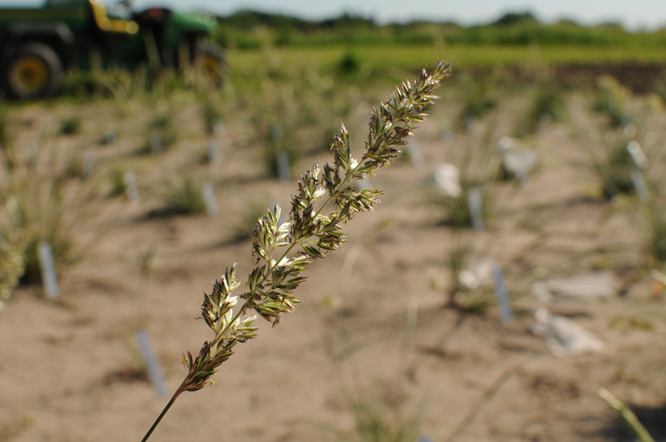From a plant improvement and plant breeding perspective, self-incompatibility systems limit the methods available to plant breeders in their programs. The turfgrass varieties that ultimately make it to commercialization are often the result of population-level breeding approaches that don’t fully take advantage of hybridization between just two elite plant parents. The advantage of hybrid breeding programs is they generally result in greater uniformity, breeders have complete parental control, and they maximize heterosis. Heterosis is when the offspring outperforms both parents for particular traits of interest. In turfgrass that could be anything from texture, color, uniformity, disease resistance, winter hardiness, etc.
Our turfgrass breeding program is interested in the self-incompatibility characteristics of prairie junegrass, Koeleria macrantha, a potential low-input turfgrass. We have previously observed uncanny uniformity in our prairie junegrass nurseries from parents to offspring, which could be an indicator of self-pollination. We are currently experimenting with various pollination techniques and genotypic combinations to test our hypothesis that prairie junegrass is self-compatible. If prairie junegrass is determined to be self-compatible, it could lead to a hybrid breeding program for the species.
To further understand self-incompatibility in grasses, we divide it into two broad categories: sporophytic and gametophytic. Sporophytic self-incompatibility is controlled by the genotype of the paternal parent. The pollen expresses proteins on its outer layer from the paternal plant. If either of the alleles (differing forms of a gene) from the paternal parent match the alleles present in the maternal plant, then the pollen will be incompatible and no seeds will form. Gametophytic self-incompatibility is controlled by the genotype of the pollen grains. So the proteins expressed on the pollen outer layer only express one of the alleles from the paternal plant. Similarly, if the alleles being expressed in the pollen match the alleles present in the maternal plant, the pollen will be incompatible and result in no seed set. This increases the chance that pollen from one plant will be compatible with another, because there are fewer incompatibile combinations. Self-incompatible grasses in the Poaceae family have primarily demonstrated gametophytic self-incompatibility.
We hope by making controlled pollinations in the greenhouse and in the lab we will be able to answer the question of self-incompatibility in prairie junegrass and incorporate these techniques into the breeding program.
This research was funded by a grant, Genetic Improvement of Prairie Junegrass, from the United States Golf Association (USGA).
